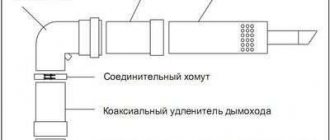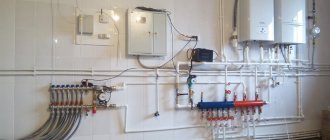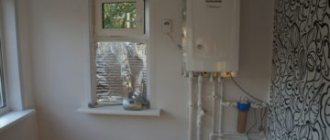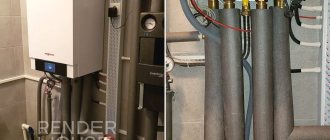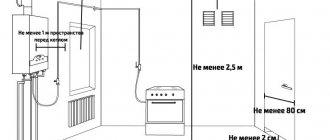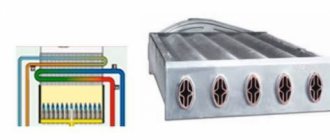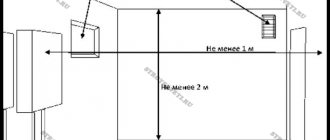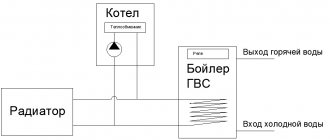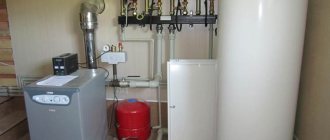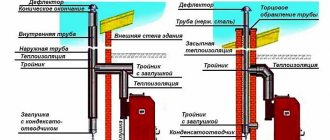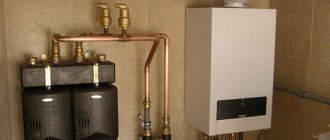In small households and country houses there is often a need to arrange a special room for gas equipment. As a rule, heating units in such buildings are located not in separate boiler rooms, but inside the house.
In this situation, it is best to use a wall-mounted gas boiler as a heat source. Such units are small in size, you can simply hang them on the wall in the kitchen, they will not interfere and will not worsen the appearance of the room.
Rules for installing gas boilers
A floor-standing boiler was installed according to the rules.
Everyone knows that gas boilers in the same model range differ in the installation method. There are two groups here - floor and wall units. Their difference is not only that they are mounted differently, but also in different technical characteristics. They differ especially from each other in power.
Floor-standing units are more powerful, while wall-mounted units are low-power. Hence their overall dimensions. Therefore, wall structures are most often installed in apartments, and floor structures are installed in private housing construction.
Requirements for floor-standing units:
- Organization of a separate room where a through hole for air flow is installed in the front door, or a window with a window is installed. The ideal solution is to install a ventilation system where air is removed from the room through a hole in the ceiling.
- Installation of a sealed chimney for a floor-standing boiler. Very often, if a high-power gas boiler is used, a double chimney is installed like a pipe in a pipe. This provides a 100% guarantee of the absolute tightness of the chimney structure.
- The boiler room itself should be spacious with free access to the heating unit for maintenance and repair work. The boiler room must be provided with water supply and sewerage.
- Since floor-standing models have significant weight, a durable floor made of non-combustible materials must be constructed under them. This could be a concrete screed, stone, paving stones, ceramic tiles, etc.
- The front door must meet certain dimensions. The minimum door width is 80 cm. SNiP also determines the minimum dimensions of the room for the boiler room. But life makes its own demands, so the optimal dimensions of the furnace room for the lowest-power floor-standing units are as follows: an area of 4 m², a ceiling height of at least 2.5 m.
- All electrical wiring for the floor-standing unit must be of a hidden type. A separate distribution panel must be installed in the boiler room.
- The walls are finished only with non-combustible materials - plaster, facing bricks, ceramic tiles and so on. It is prohibited to store flammable substances in the boiler room. Do not install a chimney exhaust or ventilation air intake nearby. Both systems should be located in different parts of the room.
Requirements for wall-mounted units
Minimum distance requirements
With this option everything is much simpler. Being installed in the kitchen, it is provided with sewerage, water supply, ventilation, and a gas line. That is, installation and connection costs are reduced significantly, and the cost of the work performed is reduced.
But there are some requirements that must be taken into account:
- Firstly, installing a wall-mounted gas boiler is only possible on a solid wall that can support its weight. Plasterboard or plywood partitions are not suitable for this.
- If the walls have already been finished before installing the gas appliance, and flammable materials were used, then a sheet of non-combustible material with a thickness of at least 3 mm must be installed under the boiler.
- There are minimum distances from the installed gas boiler to the supporting structures of the building. To the walls and ceiling - 0.5 m, to the floor - 0.8 m.
It is prohibited to connect gas boilers with your own hands. This is especially true for the gas pipeline. This has its own requirements, the main one of which is having permission to perform this type of work. If you have it, then there is no problem - you can do everything yourself.
You can adjust the boiler yourself, but we recommend entrusting the first adjustment to a professional
Here it is important to carry out everything in full compliance with the requirements specified in the instructions for the gas boiler
Differences between floor-standing and wall-mounted boilers
As a rule, a wall-mounted single- or double-circuit atmospheric gas boiler is a kind of mini-boiler room with a built-in expansion tank, a circulation pump, and an electronic control board. Options are available for equipping with a valve for connecting an indirect heating heater and weather-compensating programmers.
The main advantage of a wall-mounted boiler is its compactness, low weight, high functionality, and ease of installation. This unit is ideal for installation in cramped conditions; operation in a residential area is allowed. Modern mounted boilers have sufficient power to heat a house with an area of up to 200 sq.m.
Compact wall-mounted gas boiler will fit perfectly into the modern interior of the room
Floor-standing boilers have large overall dimensions, and their weight can be 3 times the weight of a wall-mounted boiler with similar parameters. This is due to the fact that floor-mounted units, unlike wall-mounted ones, are equipped with cast iron heat exchangers.
The service life of such boilers is 20-25 years. At the same time, wall-mounted boilers with steel or copper heat exchangers will last you 8-10 years.
Recommendations for choosing a model and its power
According to the installation method, there are 3 types of boilers: floor-mounted, wall-mounted and parapet. Floor-standing ones are rarely used in apartments because they are less compact, require more area around them, and are not so convenient for connecting communications. The best solution for an apartment is a wall-hung gas boiler; most of these models correspond to the size of wall-mounted kitchen cabinets, have an excellent design and fit harmoniously into the kitchen. We recommend choosing a wall-mounted model.
One of the best modern wall-mounted models is Baxi ECO4S 24 F.
Parapet boilers are installed anywhere below the plane of the window sill and are distinguished by the fact that they simultaneously serve as a radiator, at the same time heating the room in which they are located. The chimney for parapet boilers is exclusively coaxial and, as a rule, is included in the kit.
There are single-circuit and double-circuit models. The former are focused only on heating, the latter are equipped with an additional hot water supply circuit. Therefore, if the apartment already has or is planning to install a hot water boiler, a single-circuit model is sufficient. If you want to heat hot water using a boiler, you need to study all the advantages and disadvantages of dual-circuit models.
The power should be chosen after deciding on the model, since in most cases the same model is produced with different thermal power. Calculating the minimum required power is simple: for every 10 m2 of apartment area, 1 kW of boiler power + 15-20% reserve is required. For example, for an apartment with an area of 120 m2, 16-20 kW will be quite enough. If the boiler is not equipped with a modulating burner (with the ability to adjust the flame), you should not go overboard with the boiler power, as this will lead to frequent clocking and faster wear.
How to accurately calculate the required boiler powerIndividual calculation, formula and correction factors
Design and principle of operation
Double-circuit wall-mounted boilers differ from single-circuit boilers only in the presence of an additional heat exchanger and devices for distributing productivity between the circuits. The technical device may vary from model to model, but the standard design is simple and clear: a burner to which gas is supplied and its igniters → a primary heat exchanger, inside of which there is a heating circuit coolant and a secondary heat exchanger, inside of which sanitary water from the DHW circuit circulates → product removal system combustion into the chimney.
All well-known and common models are already equipped from the factory with all the elements and components necessary for the heating system: expansion tank, circulation pump, automatic air vent, safety valve, pressure gauge, set of sensors, etc. This means that for a standard heating scheme it is enough to just connect the supply and return lines to the boiler, as well as a water source for the DHW circuit (for example, a water supply).
To clearly understand the operating principle of dual-circuit models, let’s consider the functionality of each circuit separately:
- heating - a basic circuit in which the coolant continuously circulates, heating up in the heat exchanger and releasing heat through radiators in heated rooms;
- water heating - activated only when the hot water consumption point is opened, redirects all or a certain part of the heating circuit coolant to water heating.
After closing the consumption tap, the boiler switches back to the heating circuit and heats it up if the coolant has cooled down, or goes into standby mode (background heating) if everything is fine with the temperature.
Traditional double-circuit boilers are always characterized by a delay in the supply of already heated water (from 5 to 15 seconds), but there are models without such a delay, with a built-in boiler, operating on the principle of a storage heater, which we will talk about when describing the selection criteria.
In any case, there is also a delay in the supply of hot water, independent of the boiler, associated with the length of the pipeline between the boiler and the point of consumption, where the cooled water is located.
General information about boilers, their placement
Their entry into the body causes disturbances in human life processes. In large doses, the compounds provoke the development of dangerous diseases. Don’t forget about natural gas itself: it is explosive and requires special handling when used.
In private homes, various gas boilers are used, which have different air exchange requirements. For high-power floor-mounted equipment, placement requirements have been established. Such units can be installed in a separate special building, in an extension to the main house, in the attic, basement or basement.
Additional requirements apply to objects where a floor-standing gas boiler is located:
- Area of at least 4 sq. m.
- The volume of the room is at least 8 cubic meters. m.
- The ceiling height is at least 2.2 m.
- The width of the entrance opening is at least 80 cm.
- The presence of at least one window with direct access to the air with opening doors for ventilation.
- The presence of an open air supply is a gap in a wall or window profile through which oxygen constantly flows.
- Since the object is classified as explosive, the glazing area in it must exceed 0.05 square meters. m per 1 cubic meter m. room volume.
The use of a basement and plinth is allowed with restrictions, subject to a number of additional requirements. In such premises, it is necessary to equip the main and backup ventilation systems, since disruption of the air exchange structure will lead to the threat of explosion.
Most often, wall-mounted boilers of low power are used. The average power of such heating units is 30 kW. They are provided with a productive and convenient internal combustion chamber. This equipment is subject to less stringent placement requirements. Wall-mounted boilers can be placed in the utility room, kitchen or bathroom.
A wall-mounted gas boiler can be placed in the kitchen
- Delivery of the volumes of oxygen required for the direct combustion process. If there is insufficient supply of fresh air, combustion provokes the release of excessive amounts of dangerous compounds.
- Optimal conditions are created for efficient operation of equipment.
- Removal of combustion products and the gas itself from the premises in case of equipment malfunction.
Classification of ventilation systems that are used in most private houses:
- According to the principle of creating traction: natural or forced.
- In the direction of movement: supply, exhaust, combined (coaxial).
- By design: channel or integral, without channels.
Factors influencing the parameters of the air exchange system in a room with a gas boiler:
- The power of the device, its functional features.
- Room area.
- Load on the boiler (frequency of use).
- Availability of windows and doors.
- Features of the climate of the area where the house is located (temperature, wind, precipitation, humidity, etc.).
There are several factors that influence the parameters of the air exchange system in a room with a gas boiler
Choosing a boiler for a private home
It is especially important that the required power of the gas boiler is calculated correctly. If you choose a boiler that is too small, it will not be enough for full heating and the temperature in the house will be uncomfortable.
But you shouldn’t choose a boiler that’s too powerful. This results in fuel being used inefficiently and the service life of the equipment is reduced. The choice should be made with some power reserve, since constant operation at the limit of capabilities has a bad effect on the duration of operation.
To make the right choice, you should use a simple formula.
It is necessary to divide the area of the heated room by 10. Next, multiply by the regional coefficient. It directly depends on the temperature conditions of the region where the house is located.
- For temperate latitudes 1.0−1.2
- For northern latitudes 1.5−2.0
- For southern regions 0.7−1.0
These calculations give the approximate required power according to climatic conditions. For a more detailed and accurate choice, you should also take into account the volume of the heated house and the quality of insulation.
Advantages and disadvantages
The casing is made of galvanized steel, which prolongs the service life of the housing and gives it an impeccable appearance.
Don units have the following advantages:
- high quality of work;
- wide possibilities of service and repair;
- attractive design;
- reasonable combination of quality and cost;
- resistance to sudden changes in pressure in heating circuits;
- fuel efficiency.
Products are certified by a document of quality compliance with the international form ISO 9001 - 2011. The products have received many prestigious prizes and awards.
The disadvantages include the shallow depth of the firebox in the latest models and the absence of an electric heating element in the sales kit.
Rules for installing gas boilers
Before installing a boiler in a private house, it is necessary to prepare some documents and perform certain actions. What you will need:
- Contract for the supply of natural gas for an individual developer;
- The technical conditions and installation project for gas equipment must be agreed upon with the local gas service representative. Project documentation is most often developed by specialized institutes with the appropriate license for this type of activity: gorgaz, raygaz, oblgaz, mingaz, etc.;
- Installation of gas equipment must be carried out by an installation organization;
- An engineer from a district or regional gas organization must come to the site and check that the gas connections in the furnace and kitchen are correct and that they comply with the requirements. If all standards are met, he must issue a conclusion on the basis of which the gas “valve” leading to the boiler can be opened;
- The heating system must be pressurized to P = 1.8 atm (see on the boiler pressure gauge);
- De-air the heating system;
- Check all connections for leaks;
- Be sure to install a voltage stabilizer for the boiler and preferably an uninterruptible power supply;
- Do not add antifreeze to heating water. This can damage the gaskets and lead to leaks in the heating system.
Gas boilers must be installed using a special technology that ensures the safe operation of explosive units that emit toxins in the event of a leak.
The room in which the boiler will be located must meet certain requirements. When installing a heating boiler in a private single-apartment house, the furnace room, or, as it is also called, the boiler room, can be installed on any floor, including the basement, basement and even the attic or roof. Restrictions apply to living quarters, bathrooms and toilets; it is prohibited to place a boiler in them.
To calculate the volume of the boiler room, the total thermal power of the heating equipment, instantaneous or capacitive water heaters is taken into account.
The table of the required boiler room volume is given below:
Table of the required volume of the boiler room depending on the boiler power
There are exceptions: if the heating boiler has a closed combustion chamber, then the volume of the boiler room is not standardized, and the presence of a window with access to the outside is not necessary.
To supply and exhaust air, it is necessary to ensure an influx of the required volume. To provide 23.3 kW of boiler power, 2.5 m3/hour of gas must be burned. For complete combustion of this volume, 30 m3/hour of air is required. If insufficient air is supplied, the gas does not burn completely, resulting in the formation of an extremely harmful substance, the inhalation of which negatively affects human health. If inhaled within 15 minutes, death occurs. Air should come not only from outside, but also flow from other rooms of the house. This is ensured by the presence of a gap between the door and the floor and an opening with a grille in the doors.
The heating boiler is installed on the floor at a distance of 10 cm from the wall, which must be made of non-combustible material. If there are no walls made of non-combustible materials, then protection made of fire-resistant material can be installed.
Review of popular manufacturers and prices
There are many boilers on the market, both foreign and domestic. The most expensive are models from German manufacturers: Wolf, Vaillant, Bosch and Buderus. The products of these companies are famous for their quality. A wide selection of models is offered, which allows you to choose a boiler that meets any needs.
Products from Italian companies - BAXI, Ariston and Beretta - also have excellent characteristics, but are sold at lower prices. Domestic and ZhMZ gas boilers, as well as South Korean Navien, are in high demand. In terms of price-quality ratio, Navien brand equipment is gaining increasing popularity among consumers.
"Ariston"
The products are famous for their high quality workmanship; translated from Greek, “ariston” means “best”.
The company produces four lines of wall-mounted appliances of different modifications:
- ALTEAS X. Premium line, the latest development of the company. Gas units have a built-in WI-FI module that is compatible with the Ariston Net application. The line has three modifications: ALTEAS 24 FF, 30 FF and 35 FF. The numbers in the names of the boilers indicate the rated power for which the devices are designed. The cost of the units is in the price segment from 50,000 to 70,000 rubles.
- Ariston Genus. Premium-class equipment, considered second in functionality after ALTEAS X. The equipment has a liquid crystal display and can be controlled remotely from the control panel. The line is represented by models: Evo - a traditional double-circuit gas appliance with an open or closed combustion chamber and Genus Premium - a more expensive condensing boiler. The power range of all models is from 24 kW to 35 kW. The cost of Ariston Genus boilers ranges from 54,000–72,000 rubles, the price of Premium models can reach 85 thousand rubles.
- Ariston Clas. Units with a large display and AUTO and COMFORT functions. Boilers are the optimal equipment for those who want to save money. Available with a power of 24–28 kW. The average cost is in the range of 25,000–30,000 rubles.
- Ariston Egis. The most common model in Russia. Can operate at temperatures of -50 ºС. Has an electronic control unit. The price of models is from 27,000 to 34,000 rubles.
Prices for wall-mounted gas boilers Ariston
Ariston wall-mounted gas boilers
Watch the video where the Ariston Egis boiler is presented - the most popular model in Russia.
"Baksi"
One of the largest European manufacturers. Produces equipment for heating and domestic hot water supply (hot water supply). The company has representative offices in seven countries: Italy, Great Britain, Spain, France, Germany, Russia, Turkey, as well as in Eastern Europe and the Middle East.
Buyers often prefer the following models of Baksi wall-mounted boilers:
- Baxi Main 4 and Main 5. Only these models have the heating and heating circuits combined in one heat exchanger. Therefore, these boilers are smaller in size compared to other models. Baxi Main 5 is available only with a closed combustion chamber. The power range ranges from 14 to 24 kW. The cost of Main 4 is 20-28,000 rubles, and Main 5 is 25-32,000 rubles.
- Baxi Eco 4 and Baxi Eco Compact. A distinctive feature of these models is the use of an additional stainless steel heat exchanger. Range of powers from 14 to 24 kW. Baxi Eco Compact has small dimensions. Baxi Eco 4 costs from 21,000 to 27,000, and Baxi Eco Compact – from 35,000 to 44,000 rubles
- Baxi 4 Tech and Baxi Eco 4S. Analogues of Baxi Eco 4 and Baxi Eco Compact, but more budget devices. Instead of copper ones, they are equipped with plastic supply tubes, which somewhat reduces the cost of the products.
Ferroli
The well-known Italian company produces a wide range of heating equipment, including wall-mounted units at very reasonable prices.
Ferroli line of gas appliances:
- Diva;
- Domina-N;
- Arena;
- Divatop Micro;
- Divatop-H;
- Divatop Micro-LN;
- Divatop 60;
- Domiproject-D.
The power of each of the models in the list increases by 4 kW: 24, 28, 32 kW. The cost varies from 24,000 to 42,000 rubles.
Prices for wall-mounted gas boilers Ferroli
Ferroli wall-mounted gas boilers
Bosch
A very popular German company whose products are famous for their high quality and functionality.
Produces the following series of wall-mounted gas units:
- BOSCH GAZ 7000 W. Premium wall-mounted gas boilers. The main components of all models in this series are made of brass, without the use of composites. Single-circuit devices: ZSC 24-3 MFK, ZSC 24-3 MFA, ZSC 35-3 MFA with a power of 24 kW and 33.3 kW and costing from 50,000 rubles and 66,000 rubles, respectively. Double-circuit models: ZWC 24-3 MFK, ZWC 28-3 MFK, ZWC 24-3 MFA, ZWC 28-3 MFA, ZWC 35-3 MFA with a power of 24, 28 and 35 kW. Price range - from 55,000 to 68,000 rubles.
- BOSCH GAZ 6000 W. Heating devices in this series are designed and adapted for Russian operating conditions. Single-circuit models: WBN 6000-18 H RN S5700, WBN 6000-24 H RN S5700, WBN 6000-35 H RN S5700 costing from 33,000 to 44,000 rubles. Double-circuit models: WBN 6000-18 WITH RN S5700, WBN 6000-24 WITH RN S5700, WBN 6000-12 WITH RN S5700, WBN 6000-35 WITH RN S5700, sold at prices ranging from 42 to 45 thousand rubles.
- BOSCH GAZ 4000 W. The two-circuit unit ZWA 24-2 K will cost 31,500 rubles. The price of a single-circuit device ZSA 24-2 A is from 35,000 rubles.
- Condens 5000W. High-power wall-mounted condensing units. Models BOSCH ZBR100-3 and BOSCH70-3 with a power of 99.5 kW and 69.5 kW, respectively, cost 244,000 and 219,000 rubles.
Watch the video for a description of the BOSCH GAZ 6000 W gas boiler.
Prices for wall-mounted gas boilers Bosch
Bosch wall-mounted gas boilers
Wolf
The German company has been on the market since 1963 and began with the production of devices for drying hops. Currently, it produces many types of climate control equipment, including a large number of gas heating heat generators of various modifications.
Models of gas units from Wolf:
- GGU-2(K). Traditional boilers. Expensive materials are used in their production, which explains the high cost of the products. Depending on the power of the device and the configuration with various functions, the price ranges from 107,000 to 122,000 rubles.
- GGG-1K. The units are of the classic type, but more budget-friendly. The cost varies from 57 to 65 thousand rubles.
- FGG-K. Traditional appliances, the most budget option. The latest model FGG-K-24 costs from 39,000 rubles.
- GGB-2K, GGB-2, FGB (-K). Condensing boilers. The most economical option in terms of gas consumption. They cost from 116,000 to 300,000 rubles.
Protherm
Gas equipment of the Proterm brand has been produced since 1991, the main production is located in the city of Slavice (Slovakia).
Proterm produces the following brands of wall-mounted boilers:
- "Gepard" - two-circuit devices with a power of 12 and 23 kW. Hot water is heated in a steel plate heat exchanger. Prices are set depending on the region - from 35 to 40 thousand rubles.
- "Jaguar" - two-circuit units in the basic version with a power of 11 and 24 kW. Equipped with a coaxial system. Cost - 30,000-35,000 rubles.
- "Panther" - single-circuit and double-circuit boilers with a capacity of 12, 25, 30 and 35 kW. Price - from 35 to 55 thousand rubles.
- "Tiger" is a coaxial two-circuit device with a power of 12 kW. Hot water is prepared from a built-in 45 liter boiler. It is installed in apartment buildings, country houses, and private properties. The price starts from 56,000 rubles.
- “Lynx” - condensing units with a capacity of 18, 25 and 30 kW, developed by Vaillant Group engineers based on extensive experience in operating boilers operating with hard water and poor quality gas. Price - from 33 thousand to 45 thousand rubles.
"Neva Lux"
The domestic company BaltGaz produces various gas appliances, as well as spare parts and components for them.
Currently BaltGaz produces wall-mounted gas heat generators Neva Lux of the following categories:
- BaltGaz NEVA Turbo - double-circuit convection units with a capacity of 11, 14, 18 and 24 kW. The price, depending on the region, ranges from 28 thousand to 32 thousand rubles.
- BaltGaz SL 11/14/17 series are single-circuit units with the ability to connect them to an indirect heating boiler with a capacity of 11, 14 and 17 kW. Starting price - 17,000-18,000 rubles.
- BaltGaz Turbo S - two-circuit devices with a closed chamber for gas combustion, power - 10, 11, 14, 18, 21 and 24 kW. The price of the units is 30,000-32,000 rubles.
Watch the video showing the new generation Neva Lux boilers.
ZhMZ
OJSC Zhukovsky Machine-Building Plant produces a wide range of gas floor-standing boilers; the production of wall-mounted appliances is not yet included in its program.
Vailant
Vaillant Group is one of the leaders in the production of heating equipment, which is supplied to 60 countries.
Vailant produces 7 model ranges of wall-mounted boilers:
- VAILLANT TURBOFIT VUW - consists of only one double-circuit heating unit Vaillant turboFIT VUW 242/5-2, with a power of 24.7 kW. One of the features of the model is a copper primary heat exchanger. Costs 44,700 rubles.
- VAILANT TURBOTEC PRO VUW. There is only one dual-circuit model Vailant turboTEC pro VUW 242/5-3 with a power of 24 kW. The price of the product is 62,000 rubles.
- VAILANT TURBOTEC PLUS VUW. The series is represented by 5 dual-circuit models. The power of the units increases by 4 kW, starting from 20 kW and ending with 36 kW. Prices - from 69,000 to 100,000 rubles.
- VAILANT TURBOTEC PLUS VU is a series of six single-circuit models. The power line starts from 12 kW and ends at 36 kW. Prices are lower than those of dual-circuit devices, from 56 to 89 thousand rubles.
- VAILLANT ATMOTEC PRO VUW. The series is represented by one dual-circuit model with an open chamber for gas combustion. The power of the unit is 24 kW. You will have to pay 58,000 rubles for the product.
- VAILLANT ATMOTEC PLUS VU - single-circuit units with an open combustion chamber. Presented in three models with 20, 24 and 28 kW of power. Prices range from 47 to 68 thousand rubles.
- VAILLANT ATMOTEC PLUS VUW. Double-circuit boilers with an open combustion chamber. Three models for 20, 24 and 28 kW. They cost from 65,000 to 86,000 rubles.
Buderus
Another German company in the heating industry market. Like all “Germans”, they are distinguished by the high quality of their products. It has its own production in Russia.
Line of wall-mounted boilers from:
- Condensing single- and double-circuit units Logamax plus GB172i. They are distinguished by innovative design, expanded functionality, power range: 20/28, 24, 30, 35, 42 kW. For such a device the buyer will need to pay from 84,000 to 117,000 rubles.
- Single-circuit condensing devices Logamax plus GB162. They provide the possibility of creating a cascade of boilers, have high efficiency, power range: 70, 85, 100 kW. Cost - 200,000-260,000 rubles.
- Condensing devices Logamax plus GB062. Single- and double-circuit devices with a power of 14, 20 and 24 kW. They cost 72,600, 74,700 and 76,000 rubles respectively.
- Gas appliance Buderus Logamax U072. Used for heating and hot water supply, designed for Russian conditions. Power range: 12-18-24-35 kW. Very low-budget models, cost from 34,000 to 50,000 rubles.
- Logamax U052/054. Single- and double-circuit gas heating heat generators Logamax U052 are closed type, and Logamax U054 are with an open chamber for gas combustion. Power range - 24-28 kW. The purchase will cost from 48,000 to 60,000 rubles.
- Logamax U042/044. Logamax U042 double-circuit heating units are equipped with a closed gas combustion chamber and a bithermal heat exchanger. Logamax U044 is an open type boiler with a power of 24 kW. The price is 40,000 and 37,000 rubles, respectively. Read about a wood-burning stove for your home on our website.
Step-by-step instructions for obtaining permission to install
We go to the local gas supplier, fill out and submit an application there for the installation of a gas boiler in the apartment. After some time, they must issue a conclusion on the technical feasibility of installing and connecting the boiler unit. Now it is necessary to obtain a conclusion about the proper state of ventilation. The address of the organization involved in checking ventilation ducts can be found in the fire inspection authorities or in the housing and communal services (you can usually find out the addresses of other necessary organizations here). If the ventilation is in order, we get a permit; if it does not meet the requirements, we get a conclusion on the required list of works, carry them out and again submit them for inspection to specialists who will issue a permit. We order a project from the local Gorgaz or any design bureau that has the right to carry out such work. At this stage, it is already necessary to decide on the model of the gas boiler and meter, since the project is drawn up in accordance with their technical characteristics. It is quite difficult to make changes to the project, and after it is signed, it is completely impossible (a new one is created). It is not necessary to buy a boiler and meter yet. We head to the local heating network and submit an application to refuse central heating (and, if necessary, hot water supply). You need to come here with a ready-made renovation project (installation of a gas boiler). You will also need: title documents for the apartment; technical certificate of the premises; written consent to disconnect all family members. We turn to gas workers (“Gorgaz”) and conclude an agreement for boiler maintenance. We also submit the project for approval; after its approval, you can carry out the installation of an individual heating system yourself or entrust the work to Gorgaz. At this stage, disconnection from the heating network is carried out, a boiler and gas meter are installed
Please note that the work is carried out outside the heating season, since it is necessary to drain water from the heating system of the entire house. The boiler is installed without connecting to the gas main. After completing all the work, you must contact Gorgaz to obtain an acceptance certificate for the conversion work
Gas workers will also connect the boiler to the gas main, carry out the adjustment and first start-up of the gas boiler, and put the appropriate stamp in the model passport (without this, the warranty on the boiler unit will be invalid).
Terms and definitions for gas boiler houses
To make it easier for you to understand the essence of the conversation, we will immediately explain what is called and what it is called.
A boiler room is a separate room or building, a complex of buildings and structures that has technological installations designed for processing and distributing thermal energy obtained from the incoming gas resource.
It is this fuel that is usually chosen most often for providing heat and hot water supply, since it is considered the most environmentally friendly, efficient in terms of efficiency and economical to use
Boiler installations are boiler room equipment that includes a heating unit, in our case a boiler, various devices and mechanisms that allow the production and control of thermal energy (this includes chimneys, ventilation, alarms, various automation, remote sensors, etc.) for the production needs of residential buildings. , public buildings and premises for other purposes.
Units for gas boiler houses are almost always automated, which facilitates the process of processing and supplying fuel, compared to solid fuel ones.
Consumer - a subscriber who receives thermal energy in the form of heating or hot water supply, coming from the boiler room legally in accordance with the concluded agreement, property rights, and residence.
Central boiler houses are heating buildings that provide heat supply to several facilities.
Decentralized - autonomous type boiler houses.
HPF is a dangerous production facility.
In addition, according to their purpose, heat supply facilities are divided into:
- Heating, that is, designed to equip heating, ventilation, air conditioning and hot water structures with thermoenergy.
- Heating and production - the same as in the first case with the addition of technological support for industrial buildings.
- Industrial - only for process heating. Used in industry.
Fire safety of boiler houses is a priority in the approval of design documentation for the installation of gas-using appliances.
Any gas boiler house is an object of increased danger, since the gas has explosive and fire hazardous properties if the equipment operation rules are violated
Let's now look at the documentation that regulates the fire safety requirements of buildings.
General requirements
There are certain requirements for all rooms where gas boilers are installed:
First of all, attention is paid to the lighting of the room. According to standards, one cubic meter of space requires 0.03 m² of window opening
Please note that this is a clear space through which daylight will pass. This does not take into account the window frame or partitions between the glasses. That is, the net area of double-glazed windows. A prerequisite is a supply and exhaust ventilation system. Please note that the air volume of the space should change 3 times in 1 hour. This is a prerequisite for minimizing gas pollution in the room. The window must be equipped with a window. But the exit door should lead only to the street. Many suburban developers ignore this rule and end up receiving a notification from fire inspectors about the need to comply with it. As a result, you have to break through a door in the wall, spending money, time, and effort on this.
How are the dimensions of the room and the power of the unit related?
There are also certain standards that relate to the relationship between the size of the room and the power of gas boilers.
We present to your attention several positions:
- If the power of a gas boiler for heating does not exceed 30 kW, then the volume of the boiler room can be within 7.5 m³. And this is the minimum indicator.
- If the productivity is 30–60 kW, then the volume of the room is 13.5 m³.
- If the power exceeds 60 kW, then the volume of the room is determined according to the passport data of the heating device, but not less than 15 m³.
Many consumers, especially those who decide to organize autonomous heating in a city apartment, often ask the question about the possibility of installing gas boilers for heating and determining the room for them. Let's just say that there are no strict restrictions in this regard, if all the requirements imposed by the rules and regulations of SNiP are met in these premises.
Of course, it is necessary to especially note the kitchens, where these rules and regulations are already guaranteed to be laid down by the house design. But here there is one important nuance. It is necessary to take into account the total thermal power emanating from all heating devices in the kitchen. This includes a cooking stove, heating elements, heating radiators, boilers, etc. So their total power should not exceed 150 kW.
Other requirements
Installing a gas boiler indoors
And a few more requirements:
- The ceiling height in the boiler room should not be less than 2 m.
- The boiler room must be separated from other rooms by durable fireproof partitions.
- The material from which the combustion chamber is constructed must have a temporary fire resistance limit of at least 45 minutes. That is, in the event of a fire, the walls, floor and ceiling must contain the flames of the fire during this time.
- The optimal layout option should be such that the fire from the boiler room does not spread to other rooms of a private house or apartment.
Kitchen requirements
When it comes to a private home, or more precisely, the installation of gas boilers in it, problems with requirements are solved easily and quickly. Organizing a separate furnace room will not be difficult. You will need to build a small room with your own hands that meets the necessary standards. This will have little effect on the cost of construction.
But installing a gas boiler in an apartment is much more complicated. The optimal room for this is the kitchen. But even this has certain requirements. We will not once again remind you of the norms that have already been described above. All of them must be implemented in full without any deviations.
But there are additional requirements:
Firstly, only a wall-mounted gas boiler can be installed in the kitchen, and it is better if it has a closed combustion chamber and a coaxial chimney. Currently, manufacturers offer dual-circuit models that can provide an apartment not only with an autonomous heating system, but also with full hot water. Secondly, in addition, to increase air exchange in the room, you need to make a hole in the front door and install a grille on it
The opening area should not be less than 0.02 m². If the kitchen space does not fully comply with the requirements of SNiP, then the installation of a gas boiler for heating is possible (note - POSSIBLE) if the gas regulatory authorities give permission to do so. If the kitchen in your apartment has a volume of less than 7.5 m³, then you cannot install two heating elements in it.
Types by number of circuits
Wall-mounted units are divided into single- and double-circuit. The former are intended only for heating rooms, while the latter additionally heat water.
Single-circuit
A single-circuit boiler has one heat exchanger in which the liquid is heated using heat from the burned gas. It is located above the burner in the combustion chamber and consists of a coil pipe on which a ribbed box is placed.
The materials for the manufacture of such devices are:
- cast iron;
- copper;
- steel.
The most resistant to corrosion are copper heat exchangers, but they are the most expensive. Cast iron stands are wear-resistant, but due to their fragility and heavy weight, they are usually used in floor-standing models. Wall-mounted boilers mainly use stainless steel heat exchangers.
Single-circuit units operate exclusively as heating units. To prepare hot water, it is necessary to connect additional equipment.
Dual-circuit
This heating unit has an additional DHW (hot water supply) circuit built into it. Heat exchange in it is realized in a different way - by heating one liquid from another.
The burner does not turn off. The three-way valve disconnects the primary circuit from the heating system. The coolant begins to circulate through the secondary heat exchanger, where water is heated for domestic needs.
In this case, the heating system does not function. However, a significant drop in temperature in the room is not observed, since this requires many hours of operation of the boiler to prepare hot water. In reality this never happens.
Development and approval of the project
Installation work without a design permitting the installation of a heating boiler is prohibited. First of all, this is due to the high degree of danger of the work being carried out and the further operation of the equipment.
When drawing up design documentation, the features of the premises are taken into account. It must comply with all the requirements specified in the technical specifications. In addition, the project indicates a drawing for laying gas supply communications:
- in private houses - along the entire site up to the front door in a residential building;
- in apartments - from the front door to the point where the boiler is connected to the gas network.
When installing heating boilers, it is necessary to create a project, this is due to the high degree of danger of this structure.
The preparation of such documentation can only be carried out by authorized persons who have received a license for such work and are responsible for all calculations. The owners of the premises are prohibited from editing anything or making adjustments at their own discretion. Prepared project documents are subsequently sent for approval. This issue is dealt with by the gas supply technical department. Review may take from several days to several months, depending on the complexity of the drawings and the characteristics of the premises.
Along with the project for which boiler equipment will be installed, the following must be submitted for approval:
- technical passport of the unit;
- installation and operating instructions;
- certificates confirming the boiler’s compliance with sanitary and technical standards;
- confirmation of an examination of the boiler, revealing its compliance with safety standards.
When choosing heating equipment, you need to know what gas boilers are and their characteristics
The buyer receives all these documents when purchasing equipment
If it was not possible to achieve a positive decision on the installation, you need to pay attention to the reason for the refusal. Specialists reviewing the project are required to list the actions, the implementation of which will subsequently allow obtaining permission
Once the documents are approved, you can proceed to installation work.
Operating principle of an atmospheric boiler
Typically, atmospheric gas boilers are used for heating a private house or for individual heating of an apartment. The average power of the units is in the range of 15-40 kW. This figure is considered sufficient to heat a room up to 400 sq.m.
The atmospheric burner is the main heating device; it consists of the following parts:
- Nozzle;
- Burner head;
- Ejection tube with burner holes;
- Burner;
- Flame control sensor.
Atmospheric burners come in the following types:
- Single-stage - operate in “on” and “off” modes.
- Two-stage – capable of operating in reduced or full power mode;
- With flame modulation function - provide optimal gas supply.
To make it easier to understand the principle of operation of an atmospheric boiler, imagine that a heat exchanger is installed above a lit gas stove, and a ventilation duct is located above it.
A boiler into which air enters works in a similar way; combustion products are removed under the influence of natural draft. The presence of a chimney is the main condition for the possibility of installing and operating an “aspirated” one.
The main purpose of an open gas burner is to pre-mix gas with air and then supply the resulting mixture directly to the combustion zone.
An atmospheric gas burner ensures mixing of gas with air and subsequent supply of the mixture to the combustion zone
The efficiency of operation is due to the intensification of the flame due to the supply of oxygen and reduced fuel consumption.
Ventilation device for a room with a gas boiler
ideal boiler room ventilation
There are the following types of ventilation for a gas boiler in a private house:
- Natural and mechanical based on the principle of traction;
- Exhaust, supply and combined according to purpose;
- Duct and ductless according to the design solution.
When installing ventilation in a room with a gas boiler with an open combustion chamber, the following is taken into account:
- In the room with a gas boiler, a ventilation chimney is installed to remove carbon monoxide to the street;
- A general exhaust ventilation system is installed from the room with a gas boiler;
- Supply ventilation is provided in the boiler room for a gas boiler, supplying fresh air and oxygen from the street.
Gaps in windows and doors, gaps through which air can enter the room, are quite suitable as supply ventilation for a room with a gas boiler. This is especially true for private houses, where a separate room is allocated for the boiler.
When choosing equipment, you should take into account the power of the boiler, otherwise the cost of installing gas ventilation will not be justified. The oxygen supply must be sufficient to maintain a normal flame. Otherwise, soot accumulates on the heat exchanger and heating performance decreases. If there is no air flow in the room with a gas boiler, the atmosphere in it is discharged. The oxygen level drops, and reverse draft may appear, that is, combustion products will be drawn into the room. The situation is dangerous when the boiler is installed in the kitchen. By absorbing oxygen, it will cause oxygen starvation in people: pain in the eyes, headache, malaise.
When calculating the air flow, the volume of the room in which the boiler is installed is also taken into account.
Air movement principle
With mechanical draft, the air is driven by a fan. It is located in the ventilation grille at the entrance of the air duct to the room. With natural draft, air moves due to the difference in pressure outside and indoors. And even if there is good natural draft, it would be useful to install a small exhaust fan that will support air movement.
If you equip a mechanical air supply, then increased pressure is created in the room and the exhaust air is pushed out through the air duct.
There is another type of ventilation for a gas boiler room - supply and exhaust or combined. In this case, it is a combination of the previously described systems.
Duct or ductless ventilation
Ductless ventilation for a gas boiler in a private house consists of holes in the ceiling or walls. Openings connect adjacent rooms. For example, a hole is made between the bathroom and the toilet, and a ventilation duct is led out from the toilet.
Duct ventilation of a room with a gas boiler is a complex system of ventilation pipes running throughout the house. This type is most relevant for damp and dusty rooms.
Types of floor heating devices
Boilers can be classified according to a variety of criteria. Let's look at the main characteristics that affect the quality of operation of devices.
Number of circuits in the device
The boiler can have one or two operating circuits built into it. In the first case, the device will only heat the coolant, that is, function as a heating device.
Such equipment is equipped with one heat exchanger, which significantly simplifies its design and reduces its size. True, the latter also depends on the power of the device. If single-circuit equipment is installed, you will need to purchase an additional unit to heat the water.
If the heating system uses a single-circuit boiler, then to provide the house with hot water you will need to install an additional water heater
In this case, you can additionally install an indirect heating boiler, for example, or any other device. Single-circuit boilers are chosen for heating objects that do not require hot water supply or for large houses, where all the power of the device will be used to heat the building.
Double-circuit models are capable of simultaneously heating the coolant and heating water for domestic needs. Double-circuit boilers have two heat exchangers built in, which significantly complicates the design.
There are models with a so-called bithermic heat exchanger, which is divided into segments. The coolant moves through one of them, and the heating water moves through the other. Such devices are as compact as possible, but less reliable and easy to use.
The best option can be considered units with two completely separate heat exchangers. They form less scale. In addition, the circuits are separated, so there is no need to shut off the heating segment when distributing hot water. Whereas in boilers with a bithermic heat exchanger this is exactly what happens.
Double-circuit boilers are optimally used for small residential buildings. In large areas, mandatory separation of circuits is required, which is due to safety requirements, lack of total power, etc.
Combustion chamber type
Heating boilers can be equipped with an open or closed chamber. In the first option, only natural draft is used to operate the unit.
This assumes that the oxygen necessary for the combustion process enters the chamber from the room in which the device is installed. The boiler independently, without the help of any additional equipment, takes in the amount of air necessary for its operation.
A boiler with an open chamber can operate without the use of pressurization, which makes it energy independent. True, such devices require certain conditions for safe operation.
Thus, the room must have effective ventilation. In addition, for the normal operation of a boiler of this type, it is necessary to install a full-fledged vertical chimney exhaust, which will ensure normal draft. The advantages of boilers with such a chamber include energy independence and relatively low cost, but they produce less power.
Devices with a closed chamber are distinguished by the presence of a fan that supplies air inside the device and removes flue gases from it. Therefore, the boiler does not take oxygen from the room.
The chimney in this case is also significantly different. A coaxial type system is installed, where two pipes are nested one inside the other. The internal one is intended to remove combustion products, and the external one supplies street air.
The coaxial chimney can be installed not only vertically, but also horizontally at a certain angle. The presence of a fan guarantees stable draft.
A closed chamber increases the efficiency of the boiler. This is due to the fact that maximum afterburning of fuel occurs. Thus, the advantages of such boilers include higher efficiency, better efficiency, and lower fuel consumption.
For gas boilers with closed chambers, the use of a coaxial chimney is mandatory. The system ensures the supply of air to the combustion zone and the removal of flue gases
In addition, they are safer due to the fact that the combustion cycle inside the device is completely isolated. Among the disadvantages, it is worth noting the energy dependence of the devices, which is extremely undesirable in areas where power outages are common. To ensure that the operation of the boiler is not affected by interruptions in the supply of electricity, it is recommended to use a UPS in the equipment connection diagram.
Due to the operation of the fan, such boilers are quite noisy and their cost is much higher compared to analogues with an open chamber.
Material from which the heat exchanger is made
Floor-standing boilers can be equipped with three types of heat exchangers. It’s difficult to say clearly which one is better, but let’s look at the features of each. The cast iron heat exchanger is not subject to corrosion. It is insensitive to heat shock and acid attacks.
With proper use, such a part can last 20-30 years. The main disadvantage of cast iron is its fragility, which is important to consider when transporting it and during operation.
Before installation, it is recommended to carefully check the heat exchanger for cracks. When using the boiler, it is very important to maintain the required temperature conditions and not allow a temperature difference between return and supply of 45° or more.
Otherwise, the heat exchanger may crack. Another disadvantage of cast iron is its heavy weight, which makes it difficult to install the part and its subsequent dismantling if necessary.
The best choice for a gas boiler is a cast iron heat exchanger. Such parts are not subject to corrosion, are durable and reliable. The only significant drawback is fragility
Heat exchangers made of steel are lighter and more durable. They are not prone to cracks and are not subject to deformation. Their main disadvantage is their susceptibility to corrosion and burnout.
Depending on the quality of the alloy steel, the average service life of a steel assembly will be 10-15 years. If operating conditions are violated, the part will fail much earlier.
Extending the life of a steel heat exchanger is quite simple. It is necessary to ensure that the temperature inside the boiler does not fall below the “dew point” value for the exhaust gases. If this happens, condensation will form on the walls of the part.
It is carbonic acid dissolved in water. The aggressive substance will damage the heat exchanger. Thus, it is necessary to constantly maintain a sufficiently high temperature inside the boiler, which leads to higher fuel consumption.
Heat exchangers made of copper are characterized by excellent thermal conductivity, corrosion resistance and low weight. However, they are installed extremely rarely in floor-standing boilers. This is due to the high cost and “capriciousness” of the metal. During operation of a powerful floor-standing appliance, copper wears out very quickly. For low-power wall-mounted devices, this option is more suitable.
Device burner type
The burner of a floor-standing boiler can be single, two-stage or modulating. The first option assumes that the device always produces only one power level. Two-stage allows you to choose one of two levels.
Modulation involves smooth regulation (modulation) of the power output by the device. You must understand that the maximum power of a heating device is not always in demand.
The modulation type burner allows you to regulate the boiler power, which allows you to significantly save fuel
According to experts, it is used from 15 to 30% of the time when the device is working. The rest of the time it produces less power.
Thus, modulating or at least two-stage burners are more economically profitable. They significantly increase the service life of the heating device, which is explained by a decrease in the number of switches on/off of the device.
The ability to operate at reduced power provides significant savings in energy resources. In addition, the amount of flue gases and other combustion products released into the air is reduced. Boilers with modulating and two-stage burners are suitable for use with boilers of various capacities.
Use of flue gases
Traditional boilers are convection-type devices and are designed in such a way that flue gases, along with water vapor, are immediately discharged outside. However, their temperature is high and this heat can be reused.
Condensing units collect steam released during the combustion of gaseous fuel, after which the heat is redirected to heating circuits. Due to more complete use of the energy obtained from gas processing, the productivity of both the boiler itself and the heating circuit as a whole increases significantly.
A condensing boiler is able to use part of the heat from exhaust flue gases, which significantly increases its operating efficiency and reduces fuel consumption
In this way, it is possible to achieve significant fuel savings and increase the boiler efficiency to a fantastic 100% -114%. The disadvantages of condensing boilers usually include a more complex design, which significantly increases the cost. Convection devices are simpler to make and much cheaper.
Chimney installation standards
The material for the chimney is selected depending on the fuel being burned and the type of boiler. For a gas boiler, the pipes must be cylindrical and made of metal, preferably stainless steel. Such chimneys are the safest, most durable and reliable.
The chimney is installed above the ridge of the house. A hatch for cleaning the chimney must be installed. In order to ensure convenient collection of soot during cleaning, collection and removal of condensate, an empty space under the chimney inlet is necessary.
Gas boiler chimney diagram
When installing a chimney, there should be no more than three elbows and turns. The pipe connecting the boiler and the chimney should be as short as possible, no more than 25 cm.
The vertical section at the boiler outlet must be equal to at least two diameters. Beyond this vertical section, the pipe of the connecting section must necessarily rise upward with a slope towards the boiler.
Smoke removal in this case is carried out due to natural draft through the chimney.
Following all the requirements and rules for installing gas boilers will ensure their efficient operation, durability and fire safety.
Requirements for a boiler room for a solid fuel boiler
The main indicators are minimum volumes and area. During operation of the equipment, it is necessary to carry out regular inspection and maintenance, therefore the size of the room must provide easy access to all components and devices.
In this regard, the minimum volume of the boiler room for a solid fuel boiler is regulated depending on the thermal power:
- For devices with a power of less than 30 kW – 3 m2.
- For devices from 30 to 60 kW – 5.5 m2.
- For heaters of higher power – 6 m2.
